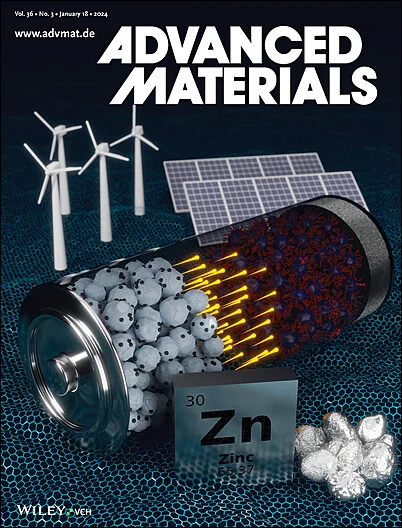Use of CsPbCl3 Quantum Dots as a Chlorine Source Enables Formation of Thick Quasi-2D Perovskite Films for High-Performance Blue Light Emitting Diodes.
IF 26.8
1区 材料科学
Q1 CHEMISTRY, MULTIDISCIPLINARY
引用次数: 0
Abstract
Achieving efficient and stable blue-emitting quasi-two-dimensional (quasi-2D) perovskite light-emitting diodes (LEDs) remains a challenge due to the poor solubility of conventional chloride precursors and the difficulty to form thick, uniform films with a well-controlled phase distribution. A new strategy is proposed to address this challenge using CsPbCl3 quantum dots (QDs) capped with oleylamine (OLA) ligands as an alternative chlorine source. It is demonstrated how the use of these QDs enables formation of quasi-2D perovskite films with vertically aligned crystalline structure, thickness over 100 nm, and improved stability. OLA ligands regulate the crystal phase distribution and grain boundaries, suppressing the appearance of small-n 2D phases and reducing the number of crystal defects, while inorganic CsPbCl3 QD cores induce vertical crystallization of quasi-2D perovskite films, endowing them with enhanced structural stability. The use of this non-conventional chlorine source is proven instrumental in improving external quantum efficiency of quasi-2D perovskite sky-blue LEDs, reaching 26.2% at 485 nm, with significantly enhanced electroluminescence stability both in terms of peak position and brightness. This study demonstrates a novel methodology using CsPbCl3 QDs capped with conventional organic ligands to achieve thick quasi-2D perovskite layers for blue LEDs, addressing existing limitations in perovskite optoelectronics.使用CsPbCl3量子点作为氯源可以形成厚的准二维钙钛矿薄膜,用于高性能蓝光发光二极管。
由于传统的氯化物前驱体溶解度差,难以形成具有良好控制相分布的厚而均匀的薄膜,因此实现高效且稳定的蓝光准二维钙钛矿发光二极管(led)仍然是一个挑战。为了解决这一问题,我们提出了一种新的策略,即使用油胺配体覆盖的CsPbCl3量子点(QDs)作为替代氯源。演示了这些量子点的使用如何使形成具有垂直排列晶体结构的准二维钙钛矿薄膜,厚度超过100 nm,并且提高了稳定性。OLA配体调节了晶相分布和晶界,抑制了小n二维相的出现,减少了晶体缺陷的数量,而无机CsPbCl3 QD芯诱导了准二维钙钛矿薄膜的垂直结晶,增强了其结构稳定性。这种非常规氯源的使用被证明有助于提高准2d钙钛矿天蓝led的外量子效率,在485 nm处达到26.2%,并且在峰值位置和亮度方面显着增强了电致发光稳定性。本研究展示了一种新的方法,使用CsPbCl3量子点覆盖传统有机配体,为蓝色led实现厚的准二维钙钛矿层,解决了钙钛矿光电子学的现有局限性。
本文章由计算机程序翻译,如有差异,请以英文原文为准。
求助全文
约1分钟内获得全文
求助全文
来源期刊

Advanced Materials
工程技术-材料科学:综合
CiteScore
43.00
自引率
4.10%
发文量
2182
审稿时长
2 months
期刊介绍:
Advanced Materials, one of the world's most prestigious journals and the foundation of the Advanced portfolio, is the home of choice for best-in-class materials science for more than 30 years. Following this fast-growing and interdisciplinary field, we are considering and publishing the most important discoveries on any and all materials from materials scientists, chemists, physicists, engineers as well as health and life scientists and bringing you the latest results and trends in modern materials-related research every week.
 求助内容:
求助内容: 应助结果提醒方式:
应助结果提醒方式:


